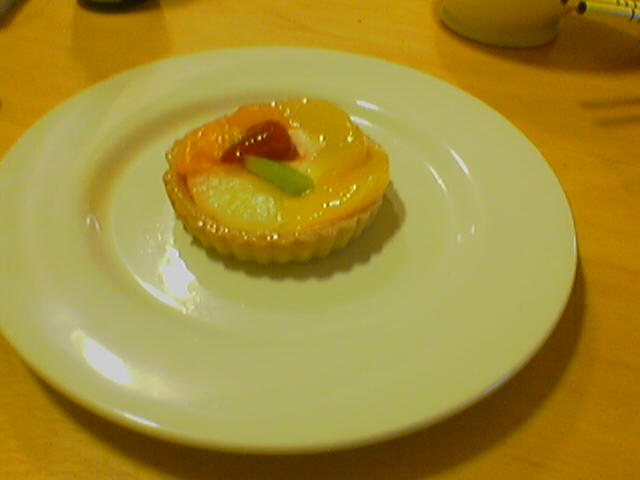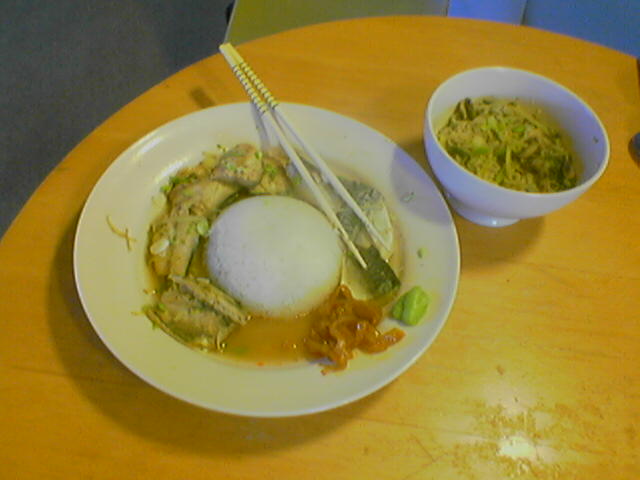Monday 11/4/2005
Back to noshblog site (click here)
Diary and Notes
According to a paper I once read (Physica D 1994, Volume 75 Pages 1-10, not the Sun or National Enquirer or some rag with tits and aliens and stories about eating hamsters - I'm a scientist don't you know) today's title is a Japanese saying concerned with how one thing affects another. The reasoning goes like this:
If the wind blows strongly then the number of blind people increase due to dust getting in their eyes. Blind people will play the shamisen to earn extra money (an traditional instrument made from cat's skin), so the demand for shamisen increases. If so cat's are hunted recklessly and the cat population declines. If there are less cats, the mouse population increases. If so wooden bath tubs are gnawed by mice and bath tubs sell well.
It may seem a little tenuous but the saying points out the subtle link between all things and was used in this paper to illustrate what a lot of people, not mathematicians I hasten to add, call the butterfly effect. This is often quoted as "A butterfly flapping it's wings in Texas can cause hurricanes in the Atlantic." and is actually a misquotation of the meteorologist Edward Lorenz who used a similar phrase with seagulls, not butterflies, to explain 'sensitive dependence to initial conditions' (and from my knowledge anyone quoting the butterfly effect has usually completely misunderstood what it is trying to describe).
So what's it got to do with today's dinner you ask? Not a lot really, but then according to the quote, everything has an effect on everything else, even if the steps between the events may be hard to see from the outset.
I will rephrase the original title as follows:
Because Japanese people come to see Stonehenge, Jon will eat mackerel for dinner
And leave it at that.
No I wont, I'll explain the steps involved:
If Japanese people wish to see Stonehenge they must come to Britain. If they wish to come to Britain they will want to learn some English in order to have an enjoyable time. If they wish to learn English they will need teaching. The teachers will scour the web for interesting websites to use in their courses. One teacher will discover a weblog in English about cooking. The teacher will send recipes to the blogger and will include mackerel in miso. The blogger will have mackerel for dinner.
This is a long winded way of describing that somebody found my website and sent me a recipe, but if I went the easy way and just said that at the start, what will we have learnt today? Nothing, and what sort of a sensi would I be.
"Oh Jon, thou art so compassionate and full of love for us all, how happy we are that you do bestow upon us your daily wisdom."
Yep, that's just how it is folks.
And a big thank you to Musha Rumi for the recipe (which I had to alter just slightly as I had no sake nor negi) but I have to say it was delicious. Apparently mackerel are very popular in Autumn and are believed to give men extra virility - be warned, I am extra potent today as I ate two.
And if you're a bit confused as to the chestnut mushrooms in a Japanese meal, those were what I had. Also, kimchi isn't Japanese it's Korean (and bloody delicious) but people tell me it's popular in Japan as well, so I thought I could have some to spice up my dinner.
*****************************************************
I Love Miso
Since I've started cooking Japanese food (from my ignorant pre Gyoza days, see 28/2/2005) I have discovered an ingredient so fantastic it will be given it's own section today, the only ingredient ever to be awarded such an honour: It's the, "I Love Miso" section and I am now going to sing the praises of this wonderful little paste in an effort to get you all to start using it.
Go and buy some miso paste and use it in European cooking, it will be fantastic. If you have a recipe that suggests using a stock cube or 'swiss bouillon' or some other slop, don't do that, squirt in some miso paste instead. The stuff is so tasty if a drop misses the pan when I'm squirting it, I wipe it up with my fingers and lick the stuff off. And if you fancy a bowl of 'cuppa soup' this is the stuff, some paste and water and the soup is far, far, better than any equivalent you have in your cupboards (apparently miso soup is very common for breakfast in Japan and on a cold day I think this would be just the thing). Why has it taken me so long to find this most fantastic of things?

Cake Blog
A 'tarte aux fruits' from Sainsbury's. Why didn't they just call it a fruit tart? Then again, why did I call today's dish saba no miso ni and not mackerel? - It just sounds more exotic.
Menu
Ingredients*
| Saba No Miso Ni 2 Small Mackerel 200ml Water 2 Tbsp Mirin 1/2 Sachet Miso Paste 1 Tbsp Japanese Soy Sauce (Shoyu) 2 Spring Onions tsp Sugar 2 tsp Grated Ginger Juice 10 Strips Thinly Sliced Ginger |
Flavoured Sticky Rice 75g Glutinous Rice 100ml Water Dash Rice Vinegar Drizzle Sesame Oil |
Ramen Pack Ramen Noodles 20g Reconstituted Wakame Seaweed 1/2 Sachet Miso Paste 3 Chestnut Mushrooms Shoyu Sauce |
Preparation
*****************************************************
3 Mai Oroshi
According to a book I have, just called Asian food with I bought last week and can't remember who it's by, it is essential to cook this mackerel dish on the bone and both the book and Rumi described a method of cutting which is traditional. Cut the head and tail off then slice lengthways along the backbone so that 1/2 the fish is a fillet and the other has all the bone. Next cut each of the two pieces into 1/2 again, making pieces 4 per fish. (Big mackerel want to be cut in half again).
*All quantities are very approximate and for a single person
JCBorresen@GMail.com
